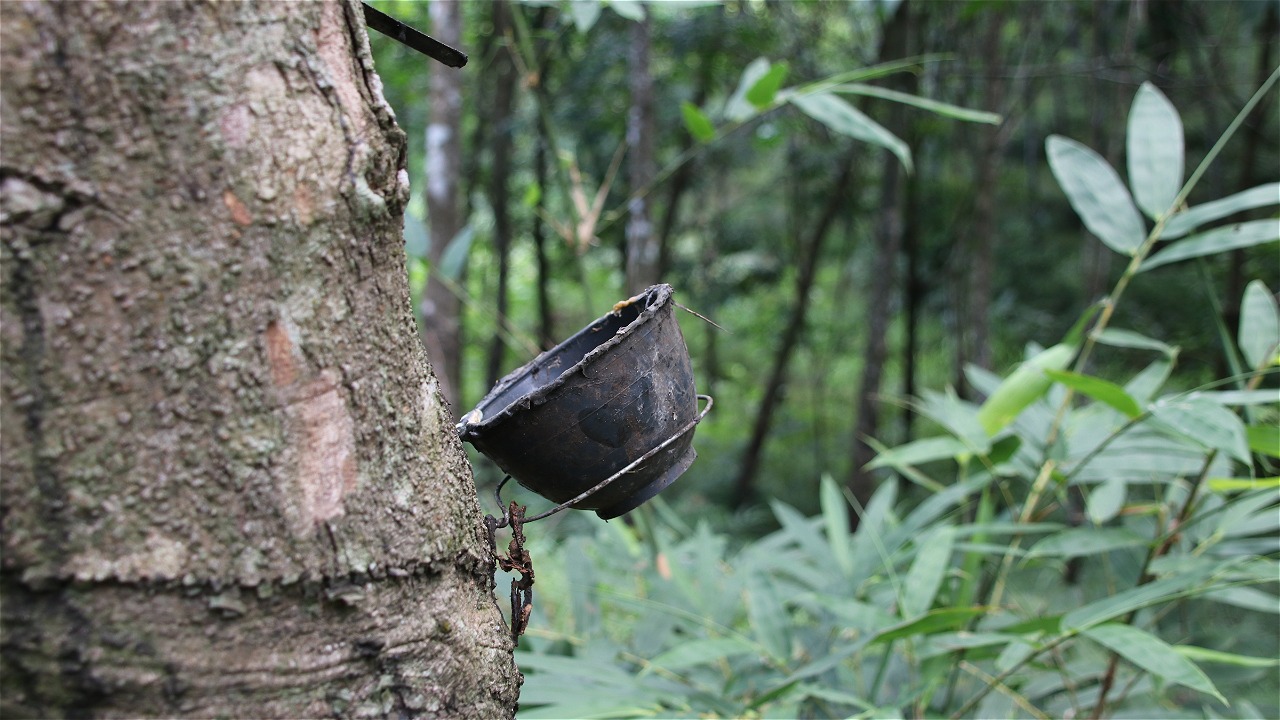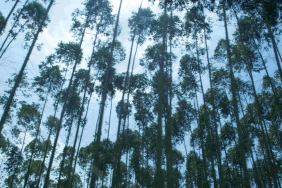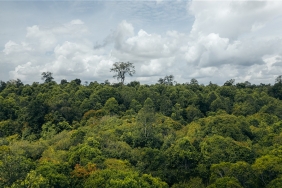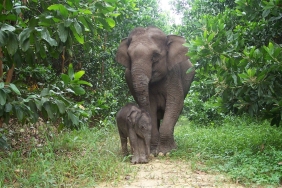PRESERVING TIGER HABITAT THROUGH SUSTAINABLE AGRICULTURE FIELD SCHOOL
By: Hijrah Nasir
The red dirt road greeted our group this morning. The rain that poured down last night caused the dirt road to be inundated with water, making it quite difficult for vehicles to pass. Occasionally, the driver who brought us had to tether an iron rope to a tree trunk to pull the car that was stuck in the mud. At the intersection leading to Trijaya Village, rubber trees lined up neatly. As we approached the village, we were greeted with rows of flowering coffee plants. There were only a few large trees on the left and right of the road. According to stories from transmigrant communities who originally settled in the area, there used to be many hardwood trees growing naturally. But along with the increasing number of people who came to these forest-fringe villages, the trees were replaced with other plantation crops. Not just coffee, rows of oil palm plantations operated by companies can be seen along the way. These conditions pose a challenge to tiger conservation efforts that can still be found in this region.
Our visit this time was to organize a sustainable farmer gathering in the hope that farmers could share knowledge and experiences about the sustainable farming field school that they have attended over the past two years. The farmers were representatives from four villages in Nasal Sub-district, Kaur Regency, Bengkulu, which borders the Bukit Barisan Selatan National Park and Kaur FMU. With great enthusiasm, they told us about the field school that they attended with the support of WWF through the Community Empowerment Program in Efforts to Preserve Key Animal Habitats in the Buffer Village of Merpas Resort of BBSNP. The four villages are Trijaya, Sukajaya, Bukit Indah, and Sumber Harapan. Each village received training in agricultural field school and livestock management. In addition, this workshop is also a place to socialize the programs that have been implemented by WWF to the Government of Kaur Regency.
"The condition of our soil is critical because of the use of too much chemical fertilizer so that micro organisms are reduced which causes the soil to not decompose properly. So it needs biological decomposition through composting. In addition, the current scarcity of fertilizers causes farmers to have difficulty finding chemical fertilizers, so farmers need to learn to make compost. In sustainable agriculture, we learn to make compost from materials that are available in nature and easily obtained. The materials include local micro-organisms. Coconut belts are also used because they contain potassium, banana stems have phosphorus content, coffee husks contain NPK, and gamal leaves as a source of nitrogen. The benefits that can be felt by farmers are that the land becomes fertile because there are many microorganisms, can fulfill macro and micro nutrients, and has economic value because it is easily available and does not need to be purchased." That's how Sampe Widayat, one of the farmers from Trijaya Village, Kaur, Bengkulu explained about the organic farming field school training he participated in before hundreds of people in Kaur District at the Sustainable Agriculture Workshop which was also attended by the Regent of Kaur, Bengkulu in the framework of Farmer Day which took place from September 19-20, 2018 in Trijaya Village.
The head of Trijaya village said that in the future the village government encourages cooperation between villages in the form of agricultural associations. For example, those who can make compost fertilizer are encouraged to make it in large quantities and the village government will help with marketing, including taking care of BPOM permits. It is hoped that in the future these four villages can make different products so that the exchange of products can run.
"These four forest buffer zone villages must be preserved because they are the lungs of the world. But the problem is, people encroach on the forest because the land they have is not satisfactory. Therefore, we strongly support the Field School program because if agricultural land is managed properly, the results will also be good. We hope that people who already have knowledge related to the principles of sustainable agriculture can share it with other communities. In addition, we also hope that creative industries can be encouraged. Women's groups, for example, can submit business planning proposals that can be supported using the village budget. In the future, it is hoped that Bumdes can become a medium for obtaining Village Original Income." Trijaya Village Head, Wahyudi, gave a speech at the workshop.
The concept of sustainable agriculture was introduced to encourage the community to intensify their agricultural land. It is hoped that in this way, the community can reduce pressure on the forest, which is still an important habitat for Sumatran tigers in Bengkulu. Sumatran tigers, whose presence in the wild is decreasing, face various threats due to poaching, habitat shrinkage, and conflicts with communities. A few years ago, it was known that tigers approached community settlements and preyed on their goats. This may be due to the tiger's reduced prey as a result of forest destruction. Not surprisingly, this triggers conflict between the community and the pressured tigers.
Learning from these facts, WWF invites the community to be actively involved in efforts to protect tiger habitat by learning sustainable agriculture and livestock management. Because the majority of people in this area raise livestock in addition to farming, they learn livestock management, ranging from how to make good cages that are resistant to wildlife attacks such as tigers, making fermented feed, vegetable pesticides for animals, and even learning to make livestock herbal medicine. Especially for fermented feed, this method has succeeded in reducing farmers' busy schedule of finding goat feed every day. Farmers are used to giving fresh feed to their goats. As a result, they have to enter the garden every day and look for grass or leaves, which takes a lot of time. After attending this training, farmers are able to prepare feed stocks for 5 days to a week.
On this occasion, the Kaur Regent was present along with the Head of the Transmigration Office, the Head of the Agriculture Office, the Kaur Village Fund Inspectorate, and the Kaur Regency Village Community Empowerment Office. "We hope that the district government can synergize with SKPD for the progress of villages in Kaur. Through this activity there is new hope because the villages here are protected forest buffers. We hope this can increase community income through the right mechanism. We need to protect the forest and prohibit forest destruction by unclear encroachers. Therefore, we must work well together and this meeting can be filled with dialog to unite the views of various parties. This meeting will be an input for us to make policies. So that when preparing the budget, village proposals can be synchronized. We also promise that in 2019 we will improve road access in Sukajaya and Trijaya along 4 km." said the Regent of Kaur, Gusril Fauzi.
In an interactive dialogue with the regent, representatives from each village expressed their problems and requests to the district government, including requests for goat assistance and how to combat pig pests, as well as complaining about the scarcity of fertilizers faced by farmers because many fertilizer distributors were caught for selling fertilizers fraudulently.
"Funds are disbursed from the center to advance from the periphery. The 4-year policy for village funds is 142 trillion of which 60 trillion for 2018 and 120 trillion for 2019. To support the economy of the village community, the products produced can be packaged well through BUMDes. Farmers who are a combination of four villages can also build a farm shop that will accommodate all agricultural tools, fertilizers, and others. This can boost the community's economy. We will help make legal regulations related to BUMDes. We thank WWF for supporting the government's efforts and filling in what the government cannot do. WWF has become a driving force to coordinate between parties, including between the government and the community. In addition, the community is given an understanding to protect forests and animals. However, now that the protected forest has been damaged, tigers have come out to disturb people's livestock. Actually, the district government created a Special Service School (special education service) to accommodate the children of encroachers who were expelled from the protected forest. So there is no reason for the community not to send their children to school. The local government is working with TNBBS and the Forestry Service to jointly protect the forest." Said the Head of the Kaur Regency Agriculture Service.
In the meeting, KPH VI Kaur Staff, Yoga Syahputra was also present. He explained that many people encroach on protected forests and production forests. In fact, currently the community can take advantage of social forestry with the Community Forest (HKm), Community Plantation Forest (HTR), and Village Forest models as long as they do not open new forests. That way it is hoped that the community can be involved together to protect the forest.
In addition to implementing community empowerment programs to support efforts to save tiger habitat, WWF also installs camera traps to monitor the presence of tiger animals that are still found in the area. WWF urges people to report to forestry officials if they see any signs of tiger presence. WWF also actively assists in the preparation or review of the Village Medium Term Development Plan (RPJMDes) to ensure conservation efforts are included in the village development program.





